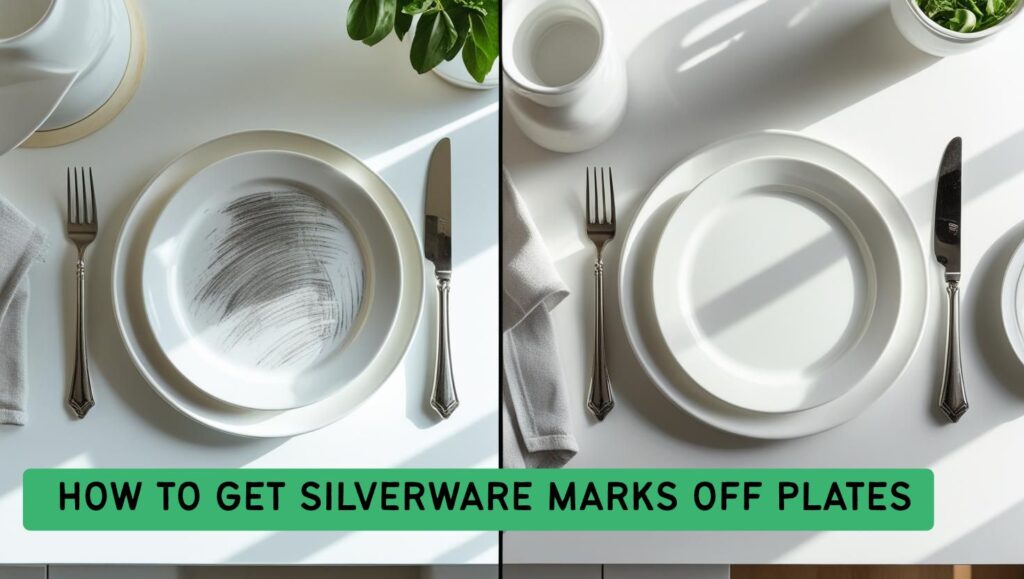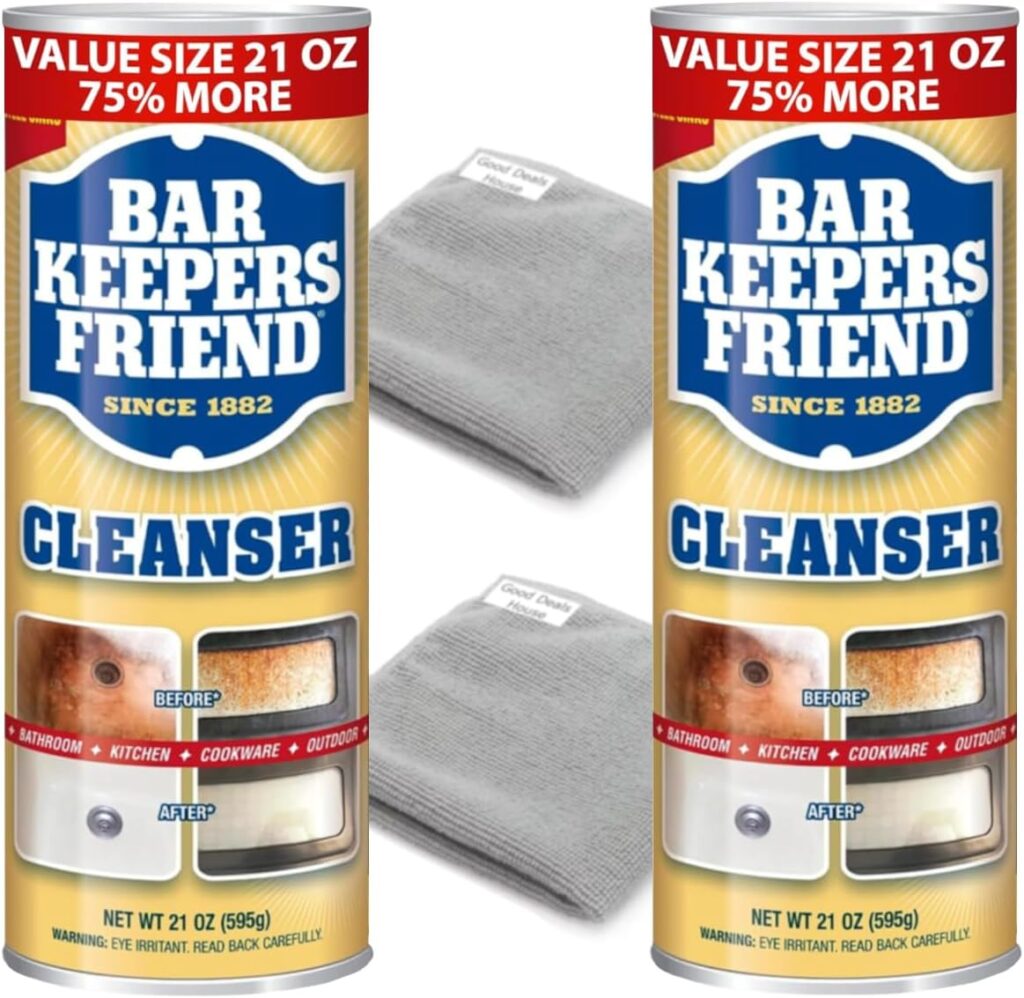You’re hosting your first dinner party in months. The menu is sorted, the wine is chilled, and you’ve spent ages perfecting every detail.
Then you pull out your favourite white dinner plates, only to discover those dreaded grey streaks marring their pristine surface.
Those unsightly silverware marks glaring back at you like accusatory fingerprints on fresh paint.
We’ve all been there. One moment you’re admiring your beautifully set table, the next you’re wondering if your guests will notice those stubborn cutlery marks on dishes.
Here’s the thing, though: those marks aren’t actually scratches at all. They’re something far more manageable than you might think.
What if I told you that removing these marks is easier than you’ve been led to believe?
That with the right technique, your plates could look showroom-fresh again in mere minutes?
Stick around, because we’re about to reveal the secrets that will transform your dinnerware game forever.
- WHAT ARE SILVERWARE MARKS REALLY?
- WHY SOME PLATES SHOW MORE MARKS THAN OTHERS
- THE SCIENCE BEHIND EFFECTIVE REMOVAL
- PROVEN METHODS ON HOW TO GET SILVERWARE MARKS OFF PLATES
- ADVANCED TECHNIQUES FOR STUBBORN MARKS
- CLEANING METHOD EFFECTIVENESS COMPARISON
- PREVENTION: THE BEST DEFENCE
- DIFFERENT PLATE MATERIALS: TAILORED APPROACHES
- COMMON MISTAKES TO AVOID
- FREQUENTLY ASKED QUESTIONS
- PROFESSIONAL TIPS FROM DINNERWARE EXPERTS
- THE ENVIRONMENTAL ANGLE
- BUILDING YOUR CLEANING ARSENAL
- CONCLUSION
WHAT ARE SILVERWARE MARKS REALLY?
Before we dive into solutions, let’s clear up a common misconception. Those grey scratches on white plates aren’t actually scratches at all.
They’re thin deposits of metal left behind by your cutlery. Think of it like a pencil mark on paper; the graphite transfers onto the surface, but the paper itself remains undamaged.
When you cut food or scrape your fork across a plate, tiny metal particles transfer from your flatware onto the ceramic surface.
This is particularly noticeable on lighter-coloured dishes where the contrast is most dramatic.
The good news? Since these are deposits rather than damage, they can be completely removed with the right approach.
WHY SOME PLATES SHOW MORE MARKS THAN OTHERS
Not all dinnerware is created equal. The surface texture and material composition play crucial roles in how susceptible your plates are to metal marks on ceramic dishes.
Glossy, smooth surfaces tend to show marks more readily than textured ones. Similarly, cheaper ceramic may be more porous, making it easier for metal particles to embed in the surface.
Silverware marks resistant dishes typically feature harder glazes or darker colours that mask any potential marking.
However, even the most premium dinnerware isn’t completely immune to this issue.
THE SCIENCE BEHIND EFFECTIVE REMOVAL
Understanding why certain cleaning methods work helps you choose the right approach.
The key lies in using mildly abrasive substances that can lift the metal deposits without damaging the plate’s surface.
It’s a delicate balance – too gentle, and you won’t budge the marks; too harsh, and you might create actual scratches.
The most effective cleaners work on a simple principle: they provide just enough abrasion to dislodge the metal particles whilst being gentle enough to preserve your plate’s finish.
This is why everyday items like baking soda and specialized products like Bar Keeper’s Friend are so effective.
PROVEN METHODS ON HOW TO GET SILVERWARE MARKS OFF PLATES

Method 1: Bar Keeper’s Friend (The Professional’s Choice)
Bar Keeper’s Friend isn’t just a marketing gimmick. It’s genuinely the gold standard for flatware marks removal.
This oxalic acid-based cleaner is gentle enough for regular use yet powerful enough to tackle the most stubborn marks.

What you’ll need:
- Bar Keeper’s Friend powder
- Soft, damp sponge
- Clean water
Step-by-step process:
- Wet the marked surface lightly
- Sprinkle a small amount of Bar Keeper’s Friend over the marks
- Let it sit for 10-15 seconds (no longer!)
- Gently scrub with a damp sponge in circular motions
- Rinse thoroughly within one minute
The beauty of this method lies in its efficiency. Most marks disappear with minimal effort, and you’ll notice an immediate difference.
Plus, it works brilliantly on scratched plates that have accumulated multiple layers of metal deposits over time.
Method 2: The Baking Soda Paste (The Natural Alternative)
For those who prefer natural cleaning solutions, baking soda is your best mate. It’s gentle, readily available, and surprisingly effective for dish cleaning hacks.

Creating the perfect paste:
- Mix 3 parts baking soda with 1 part water
- Aim for a consistency similar to thick toothpaste
- The paste should be wet enough to spread easily but thick enough to stay put
Application technique:
- Apply the paste generously over the marked areas
- Let it sit for 2-3 minutes
- Scrub gently with a soft cloth in circular motions
- Rinse with warm water and dry immediately
This method requires a bit more elbow grease than commercial cleaners, but it’s completely food-safe and won’t leave any chemical residues behind.
Method 3: Whitening Toothpaste (The Surprising Winner)
Here’s a trick that might surprise you: whitening toothpaste is remarkably effective at removing silverware marks. The mild abrasives used to remove stains from teeth work similarly on metal deposits.
Why it works so well:
- Contains gentle polishing agents
- Often includes mild bleaching components
- Readily available in most households
- Safe for food surfaces
Simply apply a small amount to the marked area, scrub gently with a soft cloth, and rinse thoroughly. You’ll be amazed at how effective this household staple can be.
ADVANCED TECHNIQUES FOR STUBBORN MARKS
The Cream of Tartar Method
For particularly persistent marks, cream of tartar offers a slightly more aggressive approach whilst remaining gentle on your dinnerware.

The process:
- Create a paste using cream of tartar and a few drops of lemon juice
- Apply to the marked areas and let sit for 5 minutes
- Scrub gently with a soft-bristled toothbrush
- Rinse thoroughly and dry
The Magic Eraser Technique
Magic erasers (melamine foam) can be effective, but use them sparingly. They’re more abrasive than they appear and can potentially damage certain plate finishes if used too aggressively.
Safety tips:
- Test on an inconspicuous area first
- Use minimal pressure
- Work in small sections
- Rinse immediately after use.
CLEANING METHOD EFFECTIVENESS COMPARISON
| Method | Effectiveness | Effort Required | Cost / Safety Rating |
| Bar Keeper’s Friend | Excellent | Low | Medium / High |
| Baking Soda Paste | Good | Medium | Very Low / Excellent |
| Whitening Toothpaste | Good | Low | Low / High |
| Cream of Tartar | Fair | Medium | Medium / High |
| Magic Eraser | Good | Low | Medium / Medium |
PREVENTION: THE BEST DEFENCE
Whilst knowing how to remove marks is essential, prevention is always preferable. Here are some strategies to minimize silverware marks on your precious dinnerware:
Choose Your Battles Wisely
Consider investing in silverware marks-resistant dishes for everyday use. Darker colours, textured surfaces, and higher-quality glazes all help mask potential marking.
Gentle Handling Techniques
- Avoid dragging cutlery across plate surfaces
- Use serving spoons for portioning rather than cutting on the plate
- Consider plastic or wooden utensils for delicate dinnerware
- Train family members (especially children) in proper table etiquette
Regular Maintenance
Don’t let marks accumulate. Address them promptly after each use, and they’ll never have the chance to become stubborn stains.
A quick wipe with a damp cloth during washing often prevents marks from setting in the first place.
DIFFERENT PLATE MATERIALS: TAILORED APPROACHES
Bone China
Bone china is generally more resistant to marking due to its dense composition, but when marks do appear, they can be more challenging to remove.
Stick to gentler methods like baking soda paste or whitening toothpaste.
Stoneware
The slightly rougher surface of stoneware can trap metal particles more readily. Bar Keeper’s Friend is particularly effective on this material, as the slight abrasiveness complements the stoneware’s durability.
Porcelain
High-quality porcelain responds well to most cleaning methods. However, be cautious with vintage or hand-painted pieces, as the decorative elements may be more delicate than the base material.
Melamine and Plastic
These materials rarely show traditional silverware marks, but they can develop scratches more easily. Focus on prevention rather than treatment with these surfaces.
COMMON MISTAKES TO AVOID
Using Harsh Abrasives:
Steel wool, scouring pads, or abrasive cleaners can cause permanent damage. Always start with the gentlest method and work your way up if needed.
Letting Cleaners Sit Too Long:
Even gentle cleaners can cause damage if left on too long. Follow recommended contact times religiously.
Ignoring the Problem:
The longer you leave silverware marks, the more embedded they become. Address them promptly for the easiest removal.
Using the Wrong Tools:
Hard brushes or rough cloths can create actual scratches whilst you’re trying to remove metal deposits. Stick to soft materials for the actual cleaning process.
FREQUENTLY ASKED QUESTIONS
No, silverware marks are surface deposits, not actual damage to the plate.
With proper cleaning techniques, they can always be removed without harming the underlying dinnerware.
For everyday dinnerware, a thorough cleaning once a week should suffice. Special occasion pieces might only need attention when marks become visible.
Not necessarily. Price doesn’t always correlate with mark resistance. Factors like glaze quality, surface texture, and colour are more important indicators.
Whilst complete prevention is unlikely with regular use, you can dramatically reduce their occurrence through gentle handling and proper techniques.
Proper cleaning with appropriate methods shouldn’t void any warranty. However, always check manufacturer guidelines for specific care instructions.
PROFESSIONAL TIPS FROM DINNERWARE EXPERTS
Industry professionals swear by a few additional tricks that can make the difference between good and exceptional results:
The Temperature Factor
Slightly warm water (not hot) helps cleaning agents work more effectively whilst preventing thermal shock to delicate ceramics.
The Drying Technique
Always dry plates immediately after cleaning to prevent water spots, which can make remaining marks more visible.
The Rotation Strategy
Rotate your dinnerware regularly so that the same pieces aren’t always taking the brunt of daily use.
When to Seek Professional Help
Sometimes, despite your best efforts, marks persist, or you’re dealing with particularly valuable pieces. Consider professional restoration services for:
- Antique or vintage dinnerware
- High-value collectibles
- Pieces with sentimental significance
- Marks that resist all home cleaning attempts
Professional ceramic restoration can work miracles, but it comes at a cost. Weigh the value of the piece against the restoration expense before proceeding.
THE ENVIRONMENTAL ANGLE
Many effective cleaning methods are environmentally friendly. Baking soda, cream of tartar, and even toothpaste break down naturally without harming waterways.
If environmental impact concerns you, prioritize these natural methods over chemical alternatives.
BUILDING YOUR CLEANING ARSENAL
Every flatware enthusiast should have these essentials in their cleaning kit:
Must-haves:
- Bar Keeper’s Friend
- Baking soda
- Soft microfibre cloths
- Non-abrasive sponges
- Whitening toothpaste (as backup)
Nice-to-haves:
- Cream of tartar
- Soft-bristled toothbrushes for detail work
- Magic erasers (for emergencies)
- Specialized ceramic cleaners
CONCLUSION
Silverware marks on plates need not be the bane of your dining experience. With the right knowledge and techniques, you can keep your dinnerware looking pristine regardless of how frequently you use it.
Remember, these marks are simply metal deposits, not permanent damage, and that makes all the difference.
The key lies in understanding your options and choosing the right method for your specific situation.
Whether you opt for the professional-grade effectiveness of Bar Keeper’s Friend, the natural approach of baking soda, or the surprising power of whitening toothpaste, success is within reach.
Prevention remains your best strategy, but when marks do appear, swift action with the proper technique will restore your plates to their former glory.